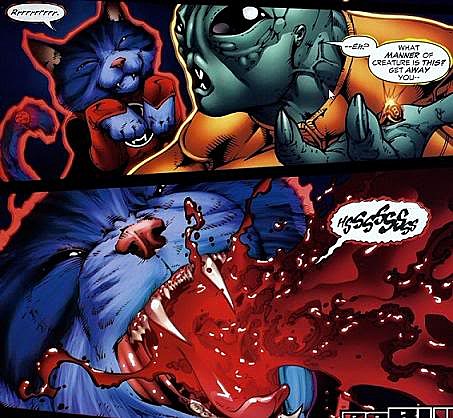
Where ‘Final Fantasy’ and Comics Collide
Last week saw the release of "Final Fantasy XIII" in North America, the latest entry in the epic RPG series from video game maker Square-Enix. At this point I'm required to make a witty remark concerning how strange it is that a series with the word "Final" in its title is releasing its thirteenth game (not counting numerous other tie-ins). And then I should add that this one will undoubtedly sell millions of copies, no matter how good or bad it is, paving the way for further sequels beyond the already announced "Final Fantasy XIV".
One of the main draws of the video game series has been its stories, the heroic journeys of ensemble casts that can last for tens of hours. And while the last few games in the series have employed a highly cinematic approach to their storytelling, earlier games didn't have that sort of technology available to them. Instead they told their stories through a mix of text, moving and static images, and music -- a hybrid form somewhere between animation and comics.
The manga tradition was likely a greater influence on the game's makers than comics published in the U.S., but any regular reader of Marvel and DC who plays games in the Final Fantasy series would find a lot that was familiar. So in honor of Final Fantasy XIII finally hitting this side of the Pacific, here are some favorite elements shared between western comics and Final Fantasy.

The artist responsible for the concept illustrations that created the core look of the Final Fantasy series and its regular bestiary of creatures, Amano got his start at animation company Tatsunoko Productions in Tokyo. His gorgeous artwork was often too complex to render accurately into the Nintendo and Super Nintendo games, but served as a constant inspiration to the sprite designers in the series. His character portraits were used in game for Final Fantasy VI, the last title in the series in which he played a major design role.Also well known for his work illustrating the "Vampire Hunter D" series, Amano's talent drew the attention of both Marvel and DC. He illustrated Neil Gaiman's "Sandman: The Dream Hunters" for Vertigo and Greg Rucka's "Elektra and Wolverine: The Redeemer" for Marvel. He also created posters of DC's best-known heroes, including one of the most striking portraits of Batman I've ever seen.


From Final Fantasy VI, here's Kefka. Product of a morally dubious science experiment that could not be said to have failed, since it did give him the power to wield magic, but could also not be said to be a perfect success, because it drove him completely insane. Face-painting, evil-laughing, mass-murdering-troops-under-his-own-command insane. Reminiscent in many ways of DC's Joker, another fan of makeup, unhinged psychopathic giggling, and not worrying all that much about collateral damage done to the lackeys he's brought along on his current job.
Both are deeply frightening villains because they're actions are unpredictable, as they don't see to care who gets hurt in the process, up to and including themselves. Kefka is like the Joker if he had a military rank, magic powers, and a higher kill count owing to the fact that he once caused an apocalypse. All of which build up to a good argument for the flame-baiting claim that he's clearly the best villain in the entire Final Fantasy series.
 Final Fantasy is a series that pulls the inspiration for its worlds from all the cultures of our own. Creatures drawn from mythologies ranging from Greek to Arabic to Hinduism are fought with weapons whose namesakes range from Celtic to Norse to Japanese. Comics have often lovingly drawn inspiration from the same sources. Both the worlds of Final Fantasy and the Marvel Universe commonly see heroes wield the hammer Mjollnir and the swords Excalibur and Masamune, and both feature frequent appearances by Odin, the Phoenix and Hades.
Final Fantasy is a series that pulls the inspiration for its worlds from all the cultures of our own. Creatures drawn from mythologies ranging from Greek to Arabic to Hinduism are fought with weapons whose namesakes range from Celtic to Norse to Japanese. Comics have often lovingly drawn inspiration from the same sources. Both the worlds of Final Fantasy and the Marvel Universe commonly see heroes wield the hammer Mjollnir and the swords Excalibur and Masamune, and both feature frequent appearances by Odin, the Phoenix and Hades.
Marvel's Thor and its own version of Norse mythology is one of its most prestigious franchises. Greg Pak and Fred Van Lente's run on "Incredible Hercules", one of the most impressive and fun Marvel titles in recent years, focused on Greek mythology. But it also included a story arc that saw Hercules form the God Squad, a team of heroes assembled from the gods and demigods from several mythologies. In using these sources, Final Fantasy and comics knit together works that are in some cases thousands of years old, reimagining them as well as making new audiences curious to go back and look at the source materials.
 Lightning, the heroine of the newest Final Fantasy game, wields a weapon that switches function between a sword and a gun. This isn't the first time that a Final Fantasy game's protagonist was given such a hybrid weapon. The designers of Final Fantasy VIII, unable to settle the age-old debate of gun versus sword amongst themselves, chose to give its hero, Squall, a weapon known as a gunblade. The device has been a little ridiculed by fans, but I continue to stand by it. Part of the problem is that the term "gunblade" is something of a misnomer. The weapon consists of an impractically large sword with a revolver chamber built into the blade. But rather than bullets, the weapon seems to use a kind of explosive cartridge, triggered by the user upon impact. In other words if you're unfortunate enough to be struck by such a weapon, first a giant blade cuts into you. And then inside that freshly opened wound a small explosive is detonated. I will never be convinced that this is not an awesome weapon.
Lightning, the heroine of the newest Final Fantasy game, wields a weapon that switches function between a sword and a gun. This isn't the first time that a Final Fantasy game's protagonist was given such a hybrid weapon. The designers of Final Fantasy VIII, unable to settle the age-old debate of gun versus sword amongst themselves, chose to give its hero, Squall, a weapon known as a gunblade. The device has been a little ridiculed by fans, but I continue to stand by it. Part of the problem is that the term "gunblade" is something of a misnomer. The weapon consists of an impractically large sword with a revolver chamber built into the blade. But rather than bullets, the weapon seems to use a kind of explosive cartridge, triggered by the user upon impact. In other words if you're unfortunate enough to be struck by such a weapon, first a giant blade cuts into you. And then inside that freshly opened wound a small explosive is detonated. I will never be convinced that this is not an awesome weapon.
Matt Fraction and Ariel Olivetti, in issue 12 of "Punisher War Journal", also decided to take the compromise position in the eternal sword versus gun debate. They arrived at a slightly different solution, however.

Airships

Planes may be a more effective way of getting around. Cars may not have that whole gravity problem to deal with. But I can't think of a better way to travel than a wooden sailing ship kept aloft by either helicopter propellers, an enormous balloon, magic, or some combination of those three. The airship has been the standard optimal means of transportation throughout the Final Fantasy series, and although it's become more technologically advanced of late I've still got a special fondness for the older models. And with the increase of steampunk's popularity they're quite common in comics, popping up in such places as Alan Moore and Kevin O'Neill's "League of Extraordinary Gentlemen", Phil and Kaja Foglio's "Girl Genius", and most recently in Warren Ellis and Raulo Caceres' "Captain Swing and the Electrical Pirates of Cindery Island". I continue to wait for the day that some wealthy fanboy with a lot of money to blow builds a working, full size replica. I hope to get a chance to ride it before its inevitable crash as a result of working steampunk being too beautiful (and impractical) for this world.
Memory Loss

You'd be hard pressed to fill a pamphlet with the accurate information these people have on their past
"A hero whose past is a mystery, either because of memory loss or withheld information, forms a team of adventurers, uncovers their own hidden secrets, and saves the world". That previous sentence summarizes the basic plot of Final Fantasy IV through Final Fantasy X. It's framing device for a story that works because, just as the audience is introduced to the main character and begins to learn about their past, the character his or herself is making the same discoveries. It's no wonder that it's also an approach that comics creators have gotten mileage out of. It was one of the main aspects of Wolverine for most of his time in the Marvel Universe. But perhaps the best title to make use of it was Warren Ellis and John Cassaday's "Planetary", one of the standout series of the last decade in comics. Elijah Snow, whose white hair and flowing clothes have a bit of a Yoshitaka Amano-esque look to them, slowly regains his own memories as he sets takes on his own quest to save the world. With somewhat more cursing.
John DiMaggio

Best known for his role as the lovable alcoholic human-hating robot Bender on Futurama, actor John DiMaggio has also contributed his voice talents to both the Final Fantasy series and to several animated versions of comic book characters. DiMaggio played several roles in Final Fantasy X, most notably Wakka (for correct pronunciation, see Fozzie Bear), a laid-back professional athlete who fought enemies by throwing a ball at them. Because this is a Final Fantasy game we're talking about, said ball obviously became a force of unstoppable destruction if you maxed the character out, capable of laying waste to any enemy encountered in impressive fashion. DiMaggio later added an enjoyable cameo in Final Fantasy XII as side-quest boss and series recurring character Gilgamesh. His most notable comics role is that of Aquaman in "Batman: the Brave and the Bold", who's quickly become a fan favorite in the series. The energy and enthusiasm DiMaggio brings to his performances is welcome wherever it shows up.

This is Mog. Mog looks like a white teddy bear with purple bat wings and a red pom-pom sticking out of his head. Mog also likes to dance. Those dances can have effects ranging from dropping rocks to crush his enemies to simply killing them instantly. If he doesn't feel like dancing, Mog can just run them through with his spear.
What I'm getting at here is that Mog, although adorable enough to have stuffed animals made in his likeness, is a brutal killing machine. His oft-repeated, seemingly friendly exclamation of "Kupo!" probably translates into something like "Death to my enemies!" Fortunately, Mog is a good guy.
 This is Dexstar. Not, not the guy in yellow. The adowable widdle kitty cat in red. Who is going to open hiz widdle mouth and vomit his widdle acidic bwood all over your soft, fleshy face, which will then most likely melt off. A Red Lantern, Dexstar is most certainly not a good guy. He's only been introduced in the past few years and hasn't had much of a role in the events of "Blackest Night", which is apparently too serious to include an evil blood spewing cat. Expect to see more of him in the future of the DC Universe, although no word on when we might be seeing stuffed animals.
This is Dexstar. Not, not the guy in yellow. The adowable widdle kitty cat in red. Who is going to open hiz widdle mouth and vomit his widdle acidic bwood all over your soft, fleshy face, which will then most likely melt off. A Red Lantern, Dexstar is most certainly not a good guy. He's only been introduced in the past few years and hasn't had much of a role in the events of "Blackest Night", which is apparently too serious to include an evil blood spewing cat. Expect to see more of him in the future of the DC Universe, although no word on when we might be seeing stuffed animals.
More From ComicsAlliance









